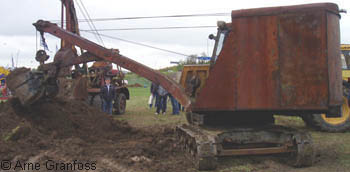Danish resistance

 UNDER CONSTRUCTION Version 0.41
UNDER CONSTRUCTION Version 0.41
|
Sweden in World War II - across borders
|
 |
![]()
![]()
![]()
On 30 April 1942 the former (by German demands) Danish politician Christmas Møller left Denmark with his wife and son, hidden on a boat that sailed to Sweden.
Later he was involved in all Danish resistance activities outside of Denmark. Among others he visited Sweden, where much of the Danish resistance was organized. [s19]
![]()
For the Danish resistance people, Sweden was a place to escape to when the situation in Denmark for the individuals became too hazardous. [s19]
The Danish resistance also received a number of weapons from Sweden (who among others manufactured weapons), without interference from the Swedish government. [s19]
![]()
![]()
On 16 September 1943 the Danish freedom council was founded in Copenhagen for cooperation between resistance groups. They had representatives in Britain and Sweden. [s13]
 The rescue operation to send Danish Jews to Sweden in October-November 1943 became a base for Danish clandestine organisations operating from among others Gothenburg, Helsingborg and Malmö in Sweden.
Boats travelled between Denmark and Sweden. Sometimes two boats met in the open sea to exchang cargo, mail and passengers.
Around 20,000 'passengers' sailed from Denmark to Sweden. From Sweden came foremost armaments from Sweden and Britain (via Sweden). [s58]
The rescue operation to send Danish Jews to Sweden in October-November 1943 became a base for Danish clandestine organisations operating from among others Gothenburg, Helsingborg and Malmö in Sweden.
Boats travelled between Denmark and Sweden. Sometimes two boats met in the open sea to exchang cargo, mail and passengers.
Around 20,000 'passengers' sailed from Denmark to Sweden. From Sweden came foremost armaments from Sweden and Britain (via Sweden). [s58]
During October 1943 Germany released the interned Danish soldiers, and the Danish army leaders planned to send the officers to Sweden. There they should form a nucleus of a force that could be used later. Plans changed, and a smaller group of officers arrived in Sweden to work with the education of a Danish "police corps". [s58]
![]()
A military committee was formed in January 1944, to create an underground army. Some of the officers that were released from detention, that began after the German declaration of emergency,
were sent to Sweden to organize a volunteer brigade among Danish refugees and with Swedish aid. In the springtime of 1945 the Danish Brigade was 56 000 men strong, and had
been equipped with heavy weapons from Britain, Sweden and Germany (of which several came from attacks on German weapon depots in Denamrk). They also had got Swedish helmets with a painted Danish flag. [s13]
Close to 5000 Danes had been trained in Sweden with Swedish weapons, for war in both summer and winter. In early May 1945 a flotilla of vessels, various boats and ships that had been sailed from Denmark to Sweden during the war, had been assembled for transports to Denmark when the war ended. [s13]
![]()
A number of Danish pilots, who had fled to Sweden in the autumn of 1943, were later trained to fly the Saab B 17. Denmark borrowed 15 planes from Sweden, to be used if needed when German troops should capitulate in Denmark. The planes were painted in Danish colors, and were ready on 5 May 1945. Luckily the capitulation took place without fighting, and the planes remained on the ground. [s75]
![]()
Among the people the Danish resistance had contacts with, was the young Swedish girl Jane Horney. She was liquidated in 1945, suspected to be a German agent. Was it true? [s06]
![]()
2019-04-07. www.granfoss.se. Text/pictures: Arne Granfoss